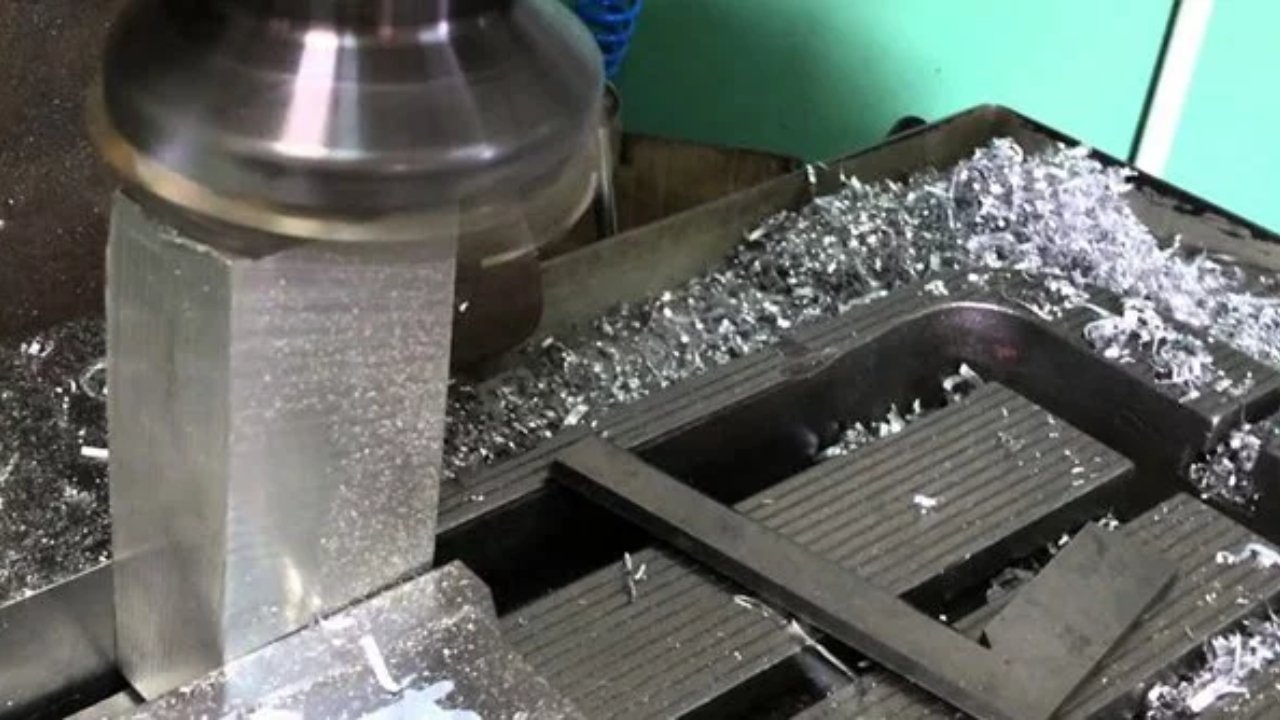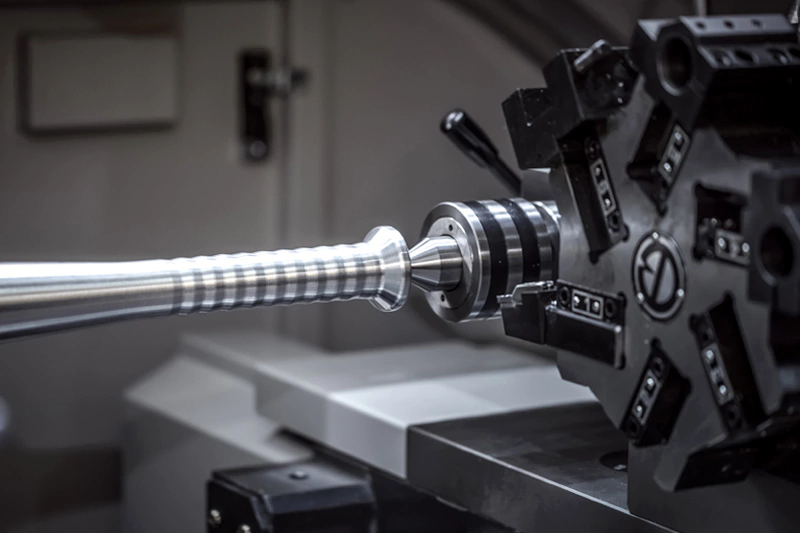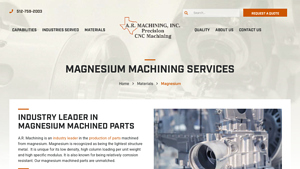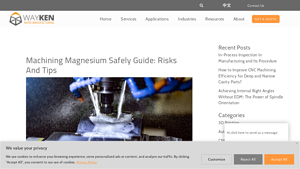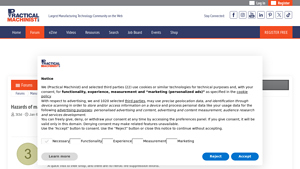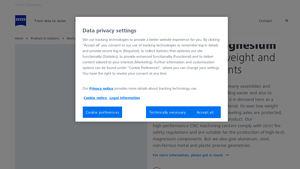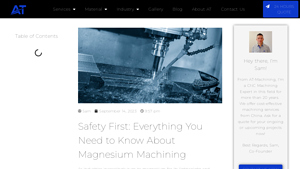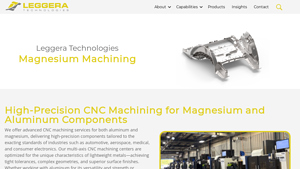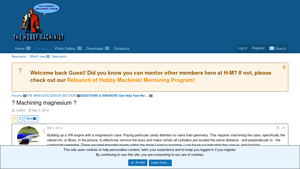Magnesium Machining Guide: Type, Cost, Top List…
Introduction: Navigating the Global Market for magnesium machining
Navigating the complexities of sourcing magnesium machining services can be a daunting task for international B2B buyers, particularly those in emerging markets like Africa, South America, and the Middle East. Magnesium machining offers unique advantages due to its lightweight properties and excellent corrosion resistance, making it an attractive option for industries such as aerospace, automotive, and electronics. However, the challenges associated with machining magnesium—such as fire hazards and the need for specialized tooling—require a nuanced understanding of best practices and supplier capabilities.
This comprehensive guide delves into the multifaceted world of magnesium machining, covering essential topics such as types of machining processes, applications across various industries, and critical factors for vetting suppliers. Buyers will gain insights into the cost implications and safety considerations necessary for successful procurement. With clear strategies and actionable tips, this guide empowers decision-makers to make informed purchasing choices that align with their operational needs and safety standards.
Whether you are a buyer from Brazil looking for reliable suppliers or a procurement officer in Saudi Arabia seeking to understand the nuances of magnesium machining, this guide serves as a valuable resource. By equipping yourself with the right knowledge and tools, you can navigate the global market with confidence, ensuring that your projects leverage the benefits of magnesium while mitigating associated risks.
Understanding magnesium machining Types and Variations
| Type Name | Key Distinguishing Features | Primary B2B Applications | Brief Pros & Cons for Buyers |
|---|---|---|---|
| CNC Machining | High precision and ability to create complex geometries | Aerospace, Automotive, Medical Devices | Pros: High accuracy, repeatability. Cons: Higher initial setup costs. |
| Lathe Machining | Rotational machining process ideal for cylindrical parts | Oil & Gas, Aerospace, Custom Components | Pros: Efficient for round parts. Cons: Limited to rotational shapes. |
| Milling | Versatile cutting process for flat or complex surfaces | Consumer Electronics, Automotive, Aerospace | Pros: Can handle diverse shapes. Cons: May require more tooling adjustments. |
| Wire EDM | Electrical discharge machining for intricate designs | Aerospace, Defense, Medical Devices | Pros: Excellent for fine details. Cons: Slower than traditional methods. |
| Surface Treatment | Enhances corrosion resistance and surface finish | Aerospace, Automotive, Industrial Applications | Pros: Improves durability. Cons: Additional processing time and cost. |
What Are the Characteristics of CNC Machining for Magnesium?
CNC machining is renowned for its precision and versatility, making it a preferred method for producing magnesium components. This technology allows for the creation of complex geometries and tight tolerances, essential in industries like aerospace and medical devices. Buyers should consider the initial setup costs, which can be higher than traditional machining methods, but the long-term benefits of efficiency and accuracy often outweigh these expenses.
How Does Lathe Machining Work for Magnesium Parts?
Lathe machining is particularly effective for manufacturing cylindrical parts, making it a popular choice in the oil and gas sector, as well as in aerospace applications. This method involves rotating the magnesium workpiece against a cutting tool, which shapes it into the desired form. While lathe machining is efficient for round components, buyers need to be aware that it is limited to specific geometries, which may restrict design options.
What Makes Milling a Versatile Option for Magnesium Machining?
Milling is a highly adaptable machining process that can produce a wide range of shapes and sizes, suitable for consumer electronics and automotive components. This method uses rotating cutters to remove material from the workpiece, allowing for intricate designs. Although milling can accommodate diverse applications, buyers should consider that it may require more frequent tooling adjustments, which can increase operational costs.
Why Choose Wire EDM for Intricate Magnesium Designs?
Wire Electrical Discharge Machining (EDM) is ideal for creating intricate designs and fine details in magnesium components. This process uses electrical discharges to cut through the material, making it particularly effective for aerospace and defense applications where precision is paramount. However, buyers should be aware that wire EDM is generally slower than traditional machining methods, which may impact production timelines.
How Do Surface Treatments Enhance Magnesium Machining?
Surface treatment processes, such as zinc phosphate coating, are essential for improving the corrosion resistance and overall durability of magnesium parts. This is especially important in aerospace and automotive industries where component longevity is critical. While these treatments add value, buyers must consider the additional processing time and costs associated with these enhancements, which can affect project timelines and budgets.
Key Industrial Applications of magnesium machining
| Industry/Sector | Specific Application of magnesium machining | Value/Benefit for the Business | Key Sourcing Considerations for this Application |
|---|---|---|---|
| Aerospace | Aircraft structural components | Lightweight, high strength-to-weight ratio | Ensure suppliers comply with aerospace standards (e.g., AS9100) and offer precision machining capabilities. |
| Automotive | Engine components and transmission parts | Improved fuel efficiency and performance | Look for suppliers with experience in high-volume production and strict quality control measures. |
| Electronics | Laptops and mobile device casings | Enhanced portability and durability | Verify the supplier’s ability to handle intricate designs and finish requirements. |
| Medical Devices | Surgical instruments and implants | Biocompatibility and reduced weight | Source from ISO-certified manufacturers with a focus on quality and safety standards. |
| Military and Defense | Lightweight weaponry and equipment | Enhanced maneuverability and reduced load | Seek suppliers with ITAR compliance and experience in defense contracts. |
How is Magnesium Machining Used in Aerospace Applications?
In the aerospace sector, magnesium machining is crucial for producing aircraft structural components, including brackets and housings. The lightweight nature of magnesium significantly contributes to overall fuel efficiency, which is a critical factor in aviation. Buyers in this industry must prioritize suppliers that adhere to stringent aerospace standards, such as AS9100, to ensure the reliability and safety of the components. Additionally, precision machining capabilities are essential to meet the complex geometries required in aircraft design.
What are the Benefits of Magnesium Machining in Automotive Manufacturing?
Magnesium machining plays a vital role in the automotive industry, particularly in the production of engine components and transmission parts. The use of magnesium alloys helps improve fuel efficiency and performance due to their low density and high strength. International buyers should focus on sourcing from manufacturers with extensive experience in high-volume production and robust quality control processes. This ensures that the parts meet the demanding standards of the automotive sector while optimizing the supply chain.
Why Choose Magnesium Machining for Electronics?
In the electronics sector, magnesium machining is employed to create lightweight casings for laptops and mobile devices. The material’s combination of durability and reduced weight enhances portability, which is a significant selling point for modern electronics. Buyers should ensure that their suppliers can handle intricate designs and surface finish requirements, as the aesthetics and functionality of these products are paramount. Additionally, sourcing from manufacturers with advanced machining capabilities can help in achieving tight tolerances necessary for electronic components.
How Does Magnesium Machining Enhance Medical Device Production?
Magnesium machining is increasingly utilized in the medical field for manufacturing surgical instruments and implants. The material’s biocompatibility and lightweight properties make it an ideal choice for medical applications where weight and patient comfort are critical. Buyers in this sector must prioritize sourcing from ISO-certified manufacturers that emphasize quality and safety standards, ensuring that the products meet regulatory requirements and perform reliably in medical settings.
What are the Key Considerations for Military Applications of Magnesium Machining?
In military and defense, magnesium machining is essential for producing lightweight weaponry and equipment, which enhances maneuverability and reduces the load for personnel. Buyers should seek suppliers that are ITAR compliant and have experience working on defense contracts. This ensures that the machining processes and materials used comply with the necessary regulations while meeting the high-performance expectations of military applications. Understanding the specific requirements for durability and weight can help in selecting the right partners for sourcing magnesium machined parts.
3 Common User Pain Points for ‘magnesium machining’ & Their Solutions
Scenario 1: Navigating Safety Hazards in Magnesium Machining
The Problem: One of the most significant concerns for B2B buyers in the magnesium machining sector is the inherent fire risk associated with the material. Magnesium dust and chips can easily ignite when exposed to heat or sparks generated during machining, posing a severe safety threat to workers and facilities. Many buyers may hesitate to engage with suppliers due to worries about the adequacy of fire suppression systems and the potential for accidents, which can lead to costly downtime and insurance complications.
The Solution: To mitigate these risks, it is crucial to prioritize safety protocols when selecting a machining partner. Buyers should specifically inquire about the safety measures implemented by potential suppliers, such as the use of explosion-proof vacuums to remove magnesium chips and dust, and the availability of Class-D fire extinguishers for magnesium fires. Additionally, ensuring that the machining facility is equipped with proper ventilation and fire suppression systems will provide peace of mind. Conducting a thorough safety audit of the supplier’s operations, including their training programs for handling magnesium, can further ensure that the supplier is committed to maintaining a safe working environment.
Scenario 2: Managing Tool Wear and Machining Efficiency
The Problem: Magnesium machining presents unique challenges in terms of tool wear and machining efficiency. The material’s relatively soft and abrasive properties can lead to rapid tool degradation, increasing both the frequency of tool replacements and operational costs. B2B buyers often find themselves facing unexpected delays in production schedules as they deal with the consequences of inefficient machining processes.
The Solution: To address tool wear concerns, buyers should specify the use of high-quality, carbide-tipped tools, which are less prone to wear and maintain their hardness under high temperatures. Moreover, opting for advanced machining techniques, such as using well-broken chip strategies and avoiding tight clearance angles, can significantly enhance tool life. Buyers can also collaborate with suppliers to develop a comprehensive tooling strategy that includes regular maintenance checks and adjustments to machining parameters, ultimately improving both efficiency and cost-effectiveness.
Scenario 3: Ensuring High-Quality Surface Finishes
The Problem: Achieving a high-quality surface finish on machined magnesium parts is often a complex endeavor. Due to the material’s properties, including its susceptibility to burr formation and deformation during machining, B2B buyers may struggle to meet stringent quality specifications, which can lead to increased rework rates and customer dissatisfaction.
The Solution: To ensure superior surface finishes, buyers should work closely with their machining partners to implement tailored machining strategies. This includes selecting the right cutting speeds, feed rates, and tool geometries that are specifically designed for magnesium. Utilizing mineral oil coolants, rather than water-based options, can also help maintain the integrity of the surface finish while reducing the risk of fire. Furthermore, conducting pre-production trials can be beneficial; this allows for adjustments based on empirical data before full-scale production begins. Establishing clear quality standards and regular inspections throughout the machining process will help guarantee that the final products meet the required specifications, thereby enhancing overall customer satisfaction.
Strategic Material Selection Guide for magnesium machining
What Are the Key Properties of Magnesium Alloys for Machining?
Magnesium alloys are widely used in machining due to their unique properties, including low density, high strength-to-weight ratio, and excellent machinability. These alloys typically have good corrosion resistance, making them suitable for various applications across industries such as aerospace, automotive, and electronics. The most common magnesium alloys used in machining include AZ31B, AZ61A, and ZK60A, each offering different performance characteristics based on their elemental composition.
What Are the Pros and Cons of Using Magnesium Alloys?
Pros:
– Lightweight: Magnesium alloys are among the lightest structural metals, which is advantageous for applications requiring weight reduction, such as in aerospace and automotive components.
– Excellent Machinability: These alloys can be easily machined, allowing for complex geometries and tight tolerances, which are critical in high-precision industries.
– Corrosion Resistance: Magnesium alloys exhibit good resistance to corrosion, particularly when treated with protective coatings.
Cons:
– Flammability: Magnesium is highly flammable, especially in the form of fine chips and dust generated during machining. This necessitates stringent safety measures and fire suppression systems.
– Tool Wear: Machining magnesium can lead to rapid tool wear due to the material’s abrasive properties, increasing operational costs and downtime.
– Cost: While magnesium alloys can be cost-effective in terms of weight savings, the initial material cost can be higher compared to other metals like aluminum or steel.
How Does Material Selection Impact Application Compatibility?
The choice of magnesium alloy can significantly impact the performance of the final product. For instance, AZ31B is often used in automotive applications due to its good mechanical properties and weldability, while ZK60A is favored in aerospace for its superior strength-to-weight ratio. Buyers must also consider the specific media compatibility of the alloys, especially in industries like oil and gas, where exposure to harsh environments is common.
What Should International B2B Buyers Consider When Selecting Magnesium Alloys?
International buyers, particularly from regions such as Africa, South America, the Middle East, and Europe, should be aware of compliance with local and international standards. Common standards include ASTM (American Society for Testing and Materials), DIN (Deutsches Institut für Normung), and JIS (Japanese Industrial Standards). Additionally, understanding the regional preferences for specific alloys and their availability is crucial for maintaining a competitive edge in the market. Buyers should also consider logistics, as magnesium alloys may require specialized handling during shipping due to their flammability.
Summary Table of Material Selection for Magnesium Machining
| Material | Typical Use Case for magnesium machining | Key Advantage | Key Disadvantage/Limitation | Relative Cost (Low/Med/High) |
|---|---|---|---|---|
| AZ31B | Automotive components, camera bodies | Good weldability and machinability | Flammable, requires careful handling | Medium |
| AZ61A | Aerospace parts, military applications | High strength-to-weight ratio | Increased tool wear, higher machining costs | High |
| ZK60A | Aerospace structural components | Superior mechanical properties | Limited availability, higher cost | High |
| AM60B | Consumer electronics, power tools | Excellent corrosion resistance | More difficult to machine than other alloys | Medium |
This strategic material selection guide provides a comprehensive understanding of magnesium alloys in machining, emphasizing their properties, advantages, and specific considerations for international B2B buyers. By carefully evaluating these factors, businesses can make informed decisions that align with their operational requirements and market demands.
In-depth Look: Manufacturing Processes and Quality Assurance for magnesium machining
What Are the Main Stages of the Manufacturing Process for Magnesium Machining?
The manufacturing process for magnesium machining encompasses several key stages: material preparation, forming, assembly, and finishing. Each stage is critical to ensure that the final products meet the stringent quality and safety standards required by various industries.
How Is Material Prepared for Magnesium Machining?
Material preparation begins with sourcing high-quality magnesium alloys, which are known for their lightweight and excellent machinability. Before machining, the material is often subjected to processes such as cutting, shearing, or sawing into manageable sizes. It’s essential to ensure that the raw materials are free from contaminants and defects, as impurities can significantly impact the final product’s quality.
Proper storage conditions are also crucial. Magnesium should be stored in environments that minimize exposure to moisture and contaminants, as these factors can affect both machinability and corrosion resistance.
What Forming Techniques Are Commonly Used in Magnesium Machining?
The forming stage typically involves various machining techniques tailored to the specific requirements of the component being produced. Common techniques include:
-
CNC Milling: This method allows for precise shaping of complex geometries, making it ideal for intricate parts. CNC milling machines equipped with specialized tooling can handle magnesium alloys effectively, ensuring high precision and surface finish.
-
Turning: Lathe operations are often used for cylindrical components. Given magnesium’s characteristics, using sharp carbide tools can help reduce heat generation and improve tool life.
-
Wire EDM: Electrical Discharge Machining (EDM) is employed for creating intricate shapes and tight tolerances. This method is particularly useful for parts that require detailed features without compromising structural integrity.
During the forming process, attention must be paid to the generation of chips and dust, as magnesium is highly flammable. Implementing effective chip removal systems, such as explosion-proof vacuums, is essential to mitigate fire risks.
How Is Assembly Conducted in the Magnesium Machining Process?
The assembly stage involves integrating various machined components into a final product. This may include fastening, welding, or using adhesives to join parts together. Due to magnesium’s unique properties, it’s critical to select appropriate assembly methods that maintain the integrity and performance of the components.
Quality control during assembly is vital. Assembling components should follow a systematic approach, often guided by engineering specifications and assembly instructions to ensure that the final product meets design criteria.
What Quality Assurance Measures Are Important for Magnesium Machining?
Quality assurance in magnesium machining is vital to ensure that products meet international standards and customer specifications. Various industry-specific standards, such as ISO 9001, CE, and API, provide frameworks for quality management systems.
Which International Standards Are Relevant for Quality Assurance?
ISO 9001 is a globally recognized standard that outlines criteria for a quality management system. It emphasizes continuous improvement, customer satisfaction, and consistent quality in products and services. For B2B buyers, verifying a supplier’s ISO 9001 certification is a critical step in ensuring that they adhere to quality standards.
Additionally, industry-specific certifications may be necessary. For example, aerospace components may require compliance with AS9100, while oil and gas components might need to meet API standards. These certifications indicate that a supplier can consistently deliver products that meet regulatory and customer requirements.
What Are the Key Quality Control Checkpoints in Magnesium Machining?
Quality control checkpoints are integrated throughout the manufacturing process, typically categorized into three phases: Incoming Quality Control (IQC), In-Process Quality Control (IPQC), and Final Quality Control (FQC).
-
IQC: This phase involves inspecting raw materials upon receipt. It ensures that all incoming materials meet specified quality standards and are free from defects.
-
IPQC: During production, regular inspections are conducted to monitor machining processes. This includes checking dimensions, surface finishes, and any other critical attributes.
-
FQC: Final inspections are performed on completed products before shipping. This phase often includes functional testing and verification against customer specifications to ensure that the final product meets quality standards.
What Testing Methods Are Commonly Used in Magnesium Machining Quality Control?
Common testing methods for magnesium machined parts include:
-
Dimensional Inspection: Utilizing calipers, micrometers, and coordinate measuring machines (CMM) to verify the dimensions of machined components.
-
Visual Inspection: A thorough visual examination can identify surface defects, such as burrs or scratches, that may affect performance.
-
Non-Destructive Testing (NDT): Techniques such as ultrasonic testing or dye penetrant inspection can be employed to detect internal defects without damaging the components.
These testing methods are essential for ensuring that the machined parts meet the required specifications and are fit for their intended applications.
How Can B2B Buyers Verify Supplier Quality Control?
For B2B buyers, verifying a supplier’s quality control practices is crucial. There are several approaches to achieve this:
-
Audits: Conducting on-site audits allows buyers to assess the supplier’s manufacturing processes, quality control systems, and adherence to international standards.
-
Quality Reports: Requesting detailed quality reports can provide insight into the supplier’s past performance, including defect rates and corrective actions taken.
-
Third-Party Inspections: Engaging independent third-party inspectors can provide an unbiased assessment of the supplier’s capabilities and quality standards. This step is particularly important for international buyers who may face language barriers or cultural differences.
What Are the Quality Control and Certification Nuances for International B2B Buyers?
International B2B buyers, particularly from Africa, South America, the Middle East, and Europe, may face unique challenges in quality control and certification. Factors such as varying regulations, cultural differences, and logistical considerations can impact the procurement process.
Buyers should be aware of the specific regulatory requirements in their regions, as they may differ significantly from those in the supplier’s country. For instance, certain certifications may be more relevant in European markets than in the Middle East.
Additionally, understanding the supplier’s quality assurance practices, including their compliance with international standards and their ability to adapt to specific buyer requirements, is vital for successful partnerships. Establishing clear communication channels and expectations can help mitigate risks and ensure product quality.
In conclusion, the manufacturing processes and quality assurance for magnesium machining are intricate and require careful attention to detail. By understanding these processes and implementing robust quality control measures, B2B buyers can ensure that they procure high-quality magnesium components that meet their specific needs.
Practical Sourcing Guide: A Step-by-Step Checklist for ‘magnesium machining’
Introduction
Navigating the procurement process for magnesium machining services requires careful consideration and strategic planning. This guide provides B2B buyers with a step-by-step checklist to ensure you source high-quality magnesium machining services that meet your specific needs while minimizing risks. By following these steps, you can streamline your sourcing process and enhance the quality of your final products.
1. Define Your Technical Specifications
Establishing clear technical specifications is essential for effective communication with potential suppliers. Outline the dimensions, tolerances, and surface finishes required for your machined parts. Providing detailed specifications helps suppliers understand your expectations and reduces the likelihood of miscommunication.
2. Assess Material Requirements
Not all magnesium alloys are created equal; understanding the specific alloy that fits your application is crucial. Consider factors such as strength, corrosion resistance, and weight. This knowledge enables you to select a supplier that specializes in the appropriate magnesium alloy for your needs, ensuring optimal performance in your final product.
3. Evaluate Supplier Certifications
Before entering a partnership, verify that potential suppliers hold relevant industry certifications. Look for ISO 9001 certification, which indicates adherence to quality management standards, and ITAR registration if applicable. These certifications provide assurance that the supplier maintains high-quality processes and meets international regulations.
4. Inquire About Safety Protocols
Given the flammability risks associated with magnesium machining, it’s vital to assess the safety measures suppliers have in place. Ask about their fire suppression systems, proper disposal of chips, and training for personnel handling magnesium. Suppliers with robust safety protocols not only protect their workers but also mitigate risks to your operations.
5. Request Samples and Prototypes
Before committing to a supplier, request samples or prototypes of their work. This allows you to evaluate the quality of their machining capabilities firsthand. Pay attention to the surface finish, dimensional accuracy, and any signs of machining defects, as these factors directly impact the performance of your final products.
6. Evaluate Production Capabilities
Understanding a supplier’s production capacity is essential, especially if you anticipate high-volume orders. Inquire about their machining processes, lead times, and whether they can handle both small and large runs. A supplier with versatile production capabilities can adapt to your changing needs, ensuring timely delivery of your parts.
7. Establish Clear Communication Channels
Effective communication is the backbone of any successful supplier relationship. Discuss how updates and feedback will be handled throughout the project. Establishing clear communication channels fosters collaboration and helps address any potential issues promptly, ensuring a smoother procurement process.
By following this checklist, B2B buyers can effectively source magnesium machining services that align with their specific requirements, ultimately leading to enhanced product quality and business success.
Comprehensive Cost and Pricing Analysis for magnesium machining Sourcing
What Are the Key Cost Components in Magnesium Machining?
Understanding the cost structure of magnesium machining is crucial for international B2B buyers, especially when considering sourcing from regions like Africa, South America, the Middle East, and Europe. The primary cost components include:
-
Materials: Magnesium alloys are generally more expensive than common metals like aluminum or steel. The cost can vary significantly based on the alloy’s purity, availability, and market fluctuations. Ensuring a reliable supply chain for raw materials can mitigate price volatility.
-
Labor: Skilled labor is essential for machining magnesium due to its unique properties, such as its flammability and the need for specialized machining techniques. Labor costs will vary by region, with higher rates often found in countries with stringent labor regulations.
-
Manufacturing Overhead: This includes costs associated with equipment maintenance, facility operations, and utilities. Given that magnesium machining can require advanced technology to manage safety and precision, overhead costs may be elevated.
-
Tooling: The tooling required for machining magnesium tends to wear out faster than for other metals, leading to higher replacement costs. Utilizing high-quality carbide-tipped tools can extend tool life and improve machining efficiency.
-
Quality Control (QC): Ensuring that machined parts meet industry standards and customer specifications incurs additional costs. Quality certifications such as ISO 9001 can add to upfront costs but are essential for maintaining product integrity.
-
Logistics: Shipping costs can vary greatly based on distance, weight, and the chosen Incoterms. For international shipments, customs duties and tariffs should also be factored into the total logistics cost.
-
Margin: Suppliers typically include a profit margin that reflects their operational costs and market conditions. Understanding the margin expectations in the supplier’s country can help in negotiating better prices.
What Influences Pricing for Magnesium Machining Services?
Several factors influence the pricing of magnesium machining services:
-
Volume/MOQ: Larger orders often lead to lower per-unit costs due to economies of scale. Establishing a Minimum Order Quantity (MOQ) with suppliers can yield significant savings.
-
Specifications and Customization: Highly customized parts or those requiring intricate designs may incur higher costs due to the complexity involved in machining.
-
Material Quality and Certifications: The quality of the magnesium alloy and the presence of certifications can significantly impact pricing. Buyers should ensure that suppliers can meet their quality requirements.
-
Supplier Factors: The supplier’s location, reputation, and experience can also affect pricing. Suppliers with specialized expertise in magnesium machining may command higher prices but can offer superior quality and reliability.
-
Incoterms: The choice of Incoterms affects the distribution of shipping responsibilities and costs. Understanding these terms can lead to cost-efficient logistics arrangements.
How Can Buyers Negotiate for Better Prices in Magnesium Machining?
B2B buyers can adopt several strategies to negotiate favorable pricing:
-
Conduct Market Research: Understanding the prevailing market rates for magnesium machining services can provide leverage in negotiations.
-
Build Long-Term Relationships: Developing a partnership with suppliers can lead to better pricing, as suppliers are often willing to offer discounts for repeat business.
-
Explore Multiple Suppliers: Obtaining quotes from several suppliers can help buyers identify competitive pricing and terms.
-
Evaluate Total Cost of Ownership (TCO): When assessing costs, consider not just the price per unit but the total cost of ownership, which includes maintenance, downtime, and logistics.
-
Be Clear on Specifications: Clearly defining specifications upfront can help avoid misunderstandings that lead to increased costs later in the production process.
What Should International Buyers Consider When Sourcing Magnesium Machining?
For international buyers, especially from Africa, South America, the Middle East, and Europe, several nuances can affect sourcing decisions:
-
Regulatory Compliance: Different regions have varying regulations regarding material sourcing and machining processes. Buyers should ensure that suppliers comply with local regulations.
-
Cultural Sensitivity: Understanding cultural nuances in business practices can facilitate smoother negotiations and partnerships.
-
Currency Fluctuations: Be aware of potential currency risks that can affect pricing over time, especially in volatile markets.
-
Shipping Times and Reliability: Assess the reliability of logistics providers and shipping times, as delays can impact production schedules.
Disclaimer on Indicative Prices
Pricing for magnesium machining services is subject to change based on market conditions, material availability, and other economic factors. It is advisable for buyers to request updated quotes and conduct thorough due diligence before finalizing contracts.
Alternatives Analysis: Comparing magnesium machining With Other Solutions
Exploring Alternatives to Magnesium Machining: What Are the Options?
In the realm of precision manufacturing, choosing the right machining method is crucial for achieving optimal performance, cost-effectiveness, and safety. While magnesium machining offers unique benefits, alternative solutions may also meet specific project requirements. This section explores these alternatives, providing a detailed comparison to aid B2B buyers in making informed decisions.
| Comparison Aspect | Magnesium Machining | Aluminum Machining | Plastic Machining |
|---|---|---|---|
| Performance | High strength-to-weight ratio, excellent machinability | Good strength, lightweight, and corrosion-resistant | Versatile, can achieve intricate designs but lower strength |
| Cost | Moderate to high due to specialized safety measures | Generally lower, but varies with alloy type | Low-cost materials, often less expensive than metals |
| Ease of Implementation | Requires specialized equipment and safety protocols | Widely available machinery, easier to implement | Simple setup, can be done with standard CNC machines |
| Maintenance | High maintenance due to flammability risks and tool wear | Moderate maintenance, tools last longer than with magnesium | Low maintenance, less wear on tools |
| Best Use Case | Aerospace, automotive, and applications requiring lightweight components | General manufacturing, automotive, and consumer goods | Prototyping, custom parts, and applications where weight is not critical |
What Are the Advantages and Disadvantages of Aluminum Machining?
Aluminum machining is a popular alternative to magnesium due to its favorable properties and cost-effectiveness. Aluminum alloys are lightweight, corrosion-resistant, and have good machinability. The availability of machinery and the relatively lower costs make aluminum machining an attractive option for many industries, including automotive and aerospace. However, aluminum does not match magnesium’s strength-to-weight ratio, and its performance in high-stress applications may not be as robust. Additionally, while aluminum’s flammability is less of a concern, it still requires careful handling during machining to prevent oxidation and surface degradation.
How Does Plastic Machining Compare?
Plastic machining offers a versatile option for manufacturers, particularly when the application does not demand the strength or weight advantages of metals. The cost-effectiveness of plastic, along with its ability to be molded into complex shapes, makes it ideal for prototyping and producing custom parts. The ease of implementation is another advantage, as standard CNC machines can handle plastic materials without the need for specialized safety measures. However, plastics generally have lower strength and thermal stability compared to magnesium and aluminum, making them less suitable for high-performance applications.
Conclusion: How to Choose the Right Machining Solution?
Selecting the appropriate machining solution involves evaluating multiple factors, including material properties, project requirements, and budget constraints. Magnesium machining stands out for applications that prioritize a high strength-to-weight ratio and excellent machinability, particularly in industries like aerospace and automotive. However, if cost and ease of implementation are critical, aluminum or plastic machining may present viable alternatives. Ultimately, B2B buyers should carefully assess their specific needs, considering factors such as performance requirements, safety protocols, and long-term maintenance costs, to make the most informed decision.
Essential Technical Properties and Trade Terminology for magnesium machining
What Are the Key Technical Properties of Magnesium Machining?
1. Material Grade
Magnesium alloys are categorized by their specific compositions, such as AZ31, AZ61, and ZK60. Each grade offers distinct properties, such as strength, corrosion resistance, and machinability. Understanding the material grade is crucial for B2B buyers as it directly affects the performance and longevity of the machined components in their applications. Selecting the appropriate grade ensures that the parts will meet the required specifications and withstand operational demands.
2. Tolerance
Tolerance refers to the allowable variation in dimensions during the machining process. Common tolerances for magnesium parts typically range from ±0.005 to ±0.010 inches, depending on the complexity of the component. Accurate tolerancing is vital for ensuring that parts fit together properly in assembly and function as intended. For B2B buyers, specifying the right tolerances can prevent costly rework and ensure that products meet industry standards.
3. Surface Finish
Surface finish is a critical property that affects both the aesthetic appeal and functional performance of machined parts. The finish is often described in terms of roughness average (Ra), with lower values indicating smoother surfaces. For magnesium components, achieving a high-quality surface finish can enhance corrosion resistance and reduce friction in mechanical applications. Buyers should specify their surface finish requirements to ensure that the final product meets their operational standards.
4. Machinability Rating
The machinability of magnesium alloys is generally rated higher than many other metals, making them easier to cut and shape. This property is essential for B2B buyers who require precision components produced efficiently and at a lower cost. A higher machinability rating can lead to reduced tool wear and lower production times, positively impacting the overall cost-effectiveness of manufacturing processes.
5. Weight-to-Strength Ratio
Magnesium boasts one of the highest weight-to-strength ratios among structural metals. This property makes it an attractive choice for industries like aerospace and automotive, where reducing weight can significantly improve performance and fuel efficiency. For B2B buyers, understanding this ratio helps in selecting materials that meet performance criteria while also adhering to weight limitations in their designs.
What Are Common Trade Terms Used in Magnesium Machining?
1. OEM (Original Equipment Manufacturer)
An OEM refers to a company that produces parts or equipment that may be marketed by another manufacturer. In the context of magnesium machining, B2B buyers often engage with OEMs to procure specific components designed for integration into larger systems. Understanding the OEM landscape is vital for buyers looking to establish partnerships for custom parts.
2. MOQ (Minimum Order Quantity)
MOQ is the smallest number of units a supplier is willing to produce or sell. In magnesium machining, MOQs can influence procurement strategies, particularly for startups or smaller businesses that may not require large quantities. B2B buyers should inquire about MOQs to optimize inventory management and cost efficiency.
3. RFQ (Request for Quotation)
An RFQ is a formal process through which buyers request pricing and terms from suppliers for specific products or services. In the context of magnesium machining, submitting an RFQ helps buyers compare costs, lead times, and capabilities of different suppliers, facilitating informed purchasing decisions.
4. Incoterms (International Commercial Terms)
Incoterms define the responsibilities of buyers and sellers regarding shipping and logistics. Understanding Incoterms is crucial for B2B buyers involved in international trade, particularly when sourcing magnesium machined parts from overseas suppliers. Proper knowledge of these terms can help mitigate risks related to shipping costs, delivery timelines, and liability.
5. Lead Time
Lead time refers to the duration from the initiation of an order to its completion and delivery. In magnesium machining, lead times can vary based on material availability, machining complexity, and production capacity. B2B buyers must consider lead times when planning production schedules to ensure timely delivery of components for their projects.
By familiarizing themselves with these technical properties and trade terms, B2B buyers can make informed decisions in sourcing magnesium machined parts, ultimately enhancing their operational efficiency and product quality.
Navigating Market Dynamics and Sourcing Trends in the magnesium machining Sector
What Are the Current Market Dynamics and Key Trends in Magnesium Machining?
The magnesium machining sector is experiencing significant growth driven by the increasing demand for lightweight materials across various industries, including automotive, aerospace, and electronics. Magnesium’s unique properties, such as low density and high strength-to-weight ratio, make it an attractive choice for manufacturers aiming to enhance fuel efficiency and reduce emissions. In emerging markets in Africa, South America, the Middle East, and Europe, the push towards sustainable manufacturing practices is further propelling the adoption of magnesium components.
International B2B buyers are increasingly leveraging advanced technologies to optimize sourcing strategies. The integration of Industry 4.0 technologies, such as IoT and AI, is revolutionizing supply chain management by enabling real-time monitoring and predictive analytics. This trend is particularly relevant in regions like Brazil and Saudi Arabia, where industrial growth is coupled with a focus on technological advancement. Additionally, the rise of e-commerce platforms is streamlining procurement processes, allowing buyers to connect with suppliers globally and access a wider range of machining services.
However, the market is not without challenges. The flammability of magnesium during machining presents significant safety concerns, necessitating stringent operational protocols. Buyers must ensure that their suppliers adhere to best practices in machining magnesium to mitigate risks associated with fire hazards and tool wear. Understanding these dynamics will be crucial for international buyers looking to navigate the complexities of sourcing magnesium machined parts effectively.
How Can Sustainability and Ethical Sourcing Impact Magnesium Machining?
Sustainability is becoming an essential consideration for B2B buyers in the magnesium machining sector. The environmental impact of manufacturing processes is under scrutiny, with an increasing emphasis on reducing carbon footprints and minimizing waste. As magnesium is often sourced from mining operations, it is vital for buyers to assess the environmental practices of their suppliers. This includes evaluating the use of energy-efficient technologies and the implementation of waste recycling programs.
Ethical sourcing is equally critical, particularly in regions where labor practices may be less regulated. Buyers should prioritize suppliers that demonstrate transparency in their supply chains and adhere to fair labor practices. Certifications such as ISO 14001 for environmental management and ISO 45001 for occupational health and safety can serve as indicators of a supplier’s commitment to sustainability and ethical practices.
Incorporating ‘green’ materials and processes in magnesium machining can also enhance a company’s brand reputation and appeal to environmentally conscious consumers. As the market shifts towards more sustainable practices, buyers who prioritize ethical sourcing and sustainability will not only comply with regulations but also gain a competitive edge in the global marketplace.
What Is the Evolution of Magnesium Machining for B2B Buyers?
The evolution of magnesium machining can be traced back to its early adoption in the aerospace and automotive industries, where weight reduction was paramount. Initially, challenges such as high flammability and complex machining processes limited its use. However, advancements in machining technologies and better understanding of magnesium’s properties have led to improved safety measures and more efficient machining methods.
Over the past few decades, the introduction of CNC machining and precision tooling has revolutionized how manufacturers work with magnesium. These technologies enable the production of intricate designs and complex geometries, making magnesium a viable option for a broader range of applications, including electronics and medical devices. As international B2B buyers increasingly seek lightweight, high-performance materials, the evolution of magnesium machining will continue to play a pivotal role in meeting industry demands and fostering innovation.
Conclusion
Understanding the market dynamics and trends in magnesium machining is essential for international B2B buyers looking to make informed sourcing decisions. With sustainability and ethical considerations becoming increasingly important, businesses must adapt to these changes to remain competitive. The ongoing evolution of machining technologies further enhances the potential of magnesium, making it a material of choice for various applications across the globe.
Frequently Asked Questions (FAQs) for B2B Buyers of magnesium machining
-
How do I ensure the safety of magnesium machining processes?
To ensure safety during magnesium machining, it’s crucial to implement strict protocols. Use sharp, carbide-tipped tools to minimize heat generation and avoid sparks. Implement a well-ventilated workspace and use explosion-proof vacuum systems for chip removal. It’s also essential to avoid water-based coolants, as they can react with magnesium and create flammable hydrogen gas. Fire extinguishing systems should be equipped with Class-D extinguishers or dry sand for magnesium fires, as water should never be used. -
What are the benefits of using magnesium in machining applications?
Magnesium is favored in machining due to its lightweight and high strength-to-weight ratio, making it ideal for industries like aerospace and automotive. Its excellent machinability allows for complex geometries and precision components, which are essential in high-performance applications. Additionally, magnesium offers good corrosion resistance, enhancing the longevity of machined parts. These benefits make it a preferred choice for manufacturers looking to optimize performance while reducing weight. -
What should I consider when vetting suppliers for magnesium machining?
When vetting suppliers, consider their experience and specialization in magnesium machining. Check for certifications like ISO 9001, which indicates a commitment to quality management. Evaluate their production capabilities, including the range of machining processes they offer, such as CNC milling and EDM. Additionally, inquire about their safety measures and compliance with international standards, especially regarding the handling of flammable materials. Client testimonials and case studies can provide insights into their reliability and service quality. -
What minimum order quantities (MOQs) should I expect for magnesium machined parts?
MOQs for magnesium machined parts can vary significantly depending on the supplier and the complexity of the components. Typically, suppliers may require a MOQ of 100 to 500 pieces for standard parts, but this can be lower for prototype or custom projects. Always discuss your specific needs with the supplier to understand their flexibility regarding order sizes. Some suppliers may offer tiered pricing based on volume, which can help in cost management for larger orders. -
What payment terms are common for international magnesium machining orders?
Common payment terms for international orders often include a deposit of 30-50% upfront, with the balance due upon completion or delivery of the parts. Some suppliers may also offer letter of credit (LC) options, which provide added security for both parties. Always clarify the payment structure and ensure it aligns with your cash flow needs. It’s advisable to establish a clear contract that outlines all terms, including payment schedules, to prevent misunderstandings. -
How do I ensure quality assurance in magnesium machined parts?
Quality assurance can be ensured by choosing suppliers who follow rigorous inspection protocols. Look for suppliers with ISO certifications and those who perform in-process inspections during machining. Additionally, request detailed reports on dimensional accuracy, surface finish, and material integrity. Some suppliers may offer third-party testing or certifications to validate the quality of their products. Establishing clear quality expectations in your contract will also help maintain standards. -
What logistics considerations should I keep in mind for shipping magnesium parts?
When shipping magnesium parts, consider both domestic and international regulations regarding the transport of flammable materials. Ensure the supplier complies with all packaging and labeling requirements to prevent mishaps during transit. It’s also essential to choose a logistics partner experienced in handling such materials. Discuss shipping timelines and customs clearance processes, especially for international orders, to avoid delays. Proper documentation, including safety data sheets (SDS), should accompany the shipment. -
How can I customize magnesium machined parts for my specific needs?
Customization of magnesium machined parts typically involves collaborating closely with your supplier to define your requirements. Provide detailed specifications, including dimensions, tolerances, and surface finishes. Some suppliers may offer design assistance to optimize the manufacturability of your parts. Discuss potential material grades or treatments that may enhance performance based on your application. Establishing an iterative design process can help refine the final product to meet your exact needs.
Important Disclaimer & Terms of Use
⚠️ Important Disclaimer
The information provided in this guide, including content regarding manufacturers, technical specifications, and market analysis, is for informational and educational purposes only. It does not constitute professional procurement advice, financial advice, or legal advice.
While we have made every effort to ensure the accuracy and timeliness of the information, we are not responsible for any errors, omissions, or outdated information. Market conditions, company details, and technical standards are subject to change.
B2B buyers must conduct their own independent and thorough due diligence before making any purchasing decisions. This includes contacting suppliers directly, verifying certifications, requesting samples, and seeking professional consultation. The risk of relying on any information in this guide is borne solely by the reader.
Top 8 Magnesium Machining Manufacturers & Suppliers List
1. A.R. Machining Inc. – Magnesium Machining Services
Domain: armachining.com
Registered: 1997 (28 years)
Introduction: A.R. Machining Inc. specializes in magnesium machining services and machined parts, recognized as an industry leader in producing parts from magnesium, the lightest structural metal. Key features include low density, high column loading per unit weight, high specific modulus, and corrosion resistance. Applications include automobiles, aircraft, camera bodies, dissolvable plugs, components in lense…
2. Wayken – Machining Magnesium Safely Guide
Domain: waykenrm.com
Registered: 2013 (12 years)
Introduction: Machining Magnesium Safely Guide: Risks and Tips – Key Product Details: 1. Material: Magnesium alloys, known for high-quality components and excellent corrosion resistance. 2. Risks: Fire hazard from flammable chips and dust, faster tool wear, heat generation, and surface finish deformation. 3. Safety Tips: Maintain proper tooling condition with sharp tools, avoid tight clearance angles, make disc…
3. Practical Machinist – Safety Guidelines for Machining Magnesium
Domain: practicalmachinist.com
Registered: 2000 (25 years)
Introduction: Machining Magnesium involves specific hazards and safety precautions. Key recommendations include: 1) Maintain good housekeeping by cleaning chip pans and avoiding long-term storage of magnesium chips indoors. 2) Avoid open flames and ensure proper fire suppression measures are in place, including Class D fire extinguishers. 3) Use sharp tooling to prevent overheating and potential ignition of chi…
4. Zeiss – Magnesium Milling Solutions
Domain: zeiss.com
Registered: 1995 (30 years)
Introduction: Milling of magnesium | Extremely lightweight and stable components. Key features include: 1. Weight advantages: Magnesium components are one-third lighter than aluminum, with higher strength and good vibration damping. 2. Safe machining: High standards for machining lightweight materials, tolerances up to IT 6, and adherence to strict safety regulations. 3. Fire safety: Equipped with extinguishing…
5. AT Machining – Magnesium Solutions
Domain: at-machining.com
Registered: 2014 (11 years)
Introduction: Magnesium is the lightest of all structural metals, with approximately two-thirds the density of aluminum, making it ideal for industries like aerospace and automotive for weight savings and fuel efficiency. It has excellent machinability but poses risks due to its high flammability and susceptibility to rapid oxidation. Key safety protocols include maintaining CNC machines, using protective shiel…
6. Leggera Technologies – Advanced CNC Machining Services
Domain: leggeratech.com
Registered: 2014 (11 years)
Introduction: Leggera Technologies offers advanced CNC machining services for magnesium and aluminum components, focusing on high-precision manufacturing for industries such as automotive, aerospace, medical, and consumer electronics. Their multi-axis CNC machining centers are optimized for lightweight metals, achieving tight tolerances, complex geometries, and superior surface finishes. They provide solutions …
7. LinkedIn – Magnesium: The Lightweight Structural Metal
Domain: linkedin.com
Registered: 2002 (23 years)
Introduction: Magnesium is the lightest structural metal available, with a density about two-thirds that of aluminum, making it ideal for aerospace and automotive industries due to improved fuel efficiency. It is highly flammable and poses risks during machining, requiring specialized safety precautions. Key advantages of CNC machining magnesium include its lightweight properties, high strength-to-weight ratio,…
8. Hobby Machinist – Machining Magnesium for VW Engines
Domain: hobby-machinist.com
Registered: 2010 (15 years)
Introduction: Machining magnesium, specifically for building a VW engine with a magnesium case. Key considerations include:
– Attention to valve train geometry and machining the raised rim (Boss) of the case to ensure cylinder alignment with the crankshaft centerline.
– Use of steel threaded inserts within the machining area.
– Recommended methods to prevent fire hazards include using coolant and misting dur…
Strategic Sourcing Conclusion and Outlook for magnesium machining
In conclusion, strategic sourcing for magnesium machining presents a unique opportunity for international B2B buyers to leverage the material’s lightweight properties and superior machinability. With applications spanning aerospace, automotive, and electronics, magnesium alloys offer significant advantages in performance and efficiency. However, it is essential to recognize the safety and handling challenges associated with machining magnesium, including fire hazards and tool wear.
By partnering with experienced suppliers who prioritize safety and quality assurance, businesses can mitigate these risks while optimizing production processes. Companies should seek suppliers that provide comprehensive support, from material selection to advanced machining techniques, ensuring compliance with industry standards such as ISO 9001.
As global demand for high-performance materials continues to grow, now is the time for buyers in regions like Africa, South America, the Middle East, and Europe to act. Investing in strategic sourcing of magnesium machining services will not only enhance product offerings but also position your company as a leader in innovation. Embrace the future of manufacturing by establishing strong partnerships in magnesium machining today.
